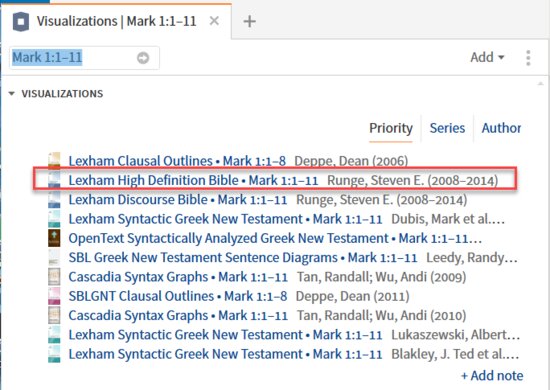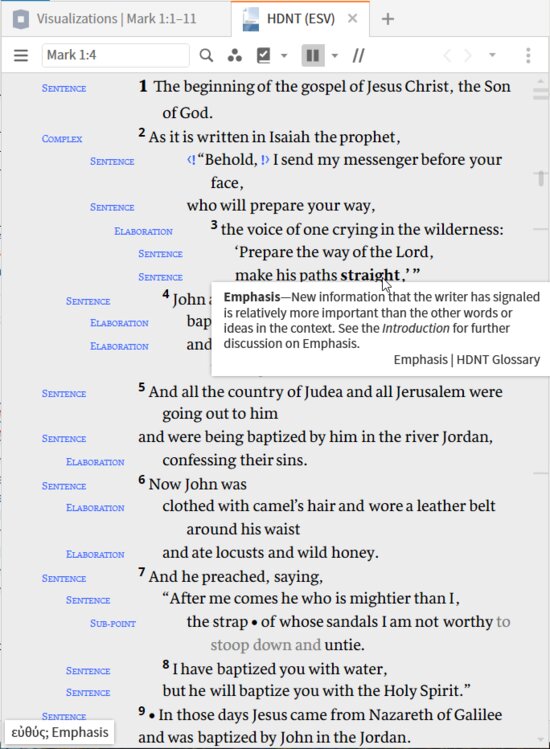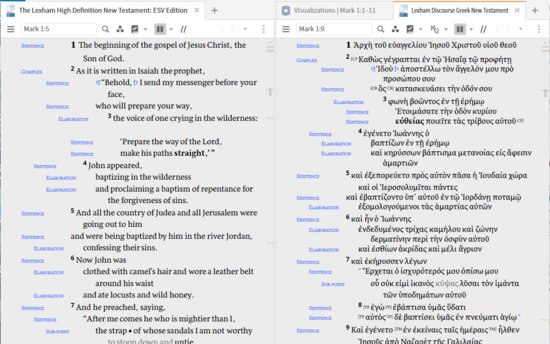Docx files for personal book: Verbum 9 part 1; Verbum 9 part 2; Verbum 9 part 3; Verbum 9 part 4; Verbum 9 part 5; Verbum 9 part 6; Verbum 9 part 7; How to use the Verbum Lectionary and Missal; Verbum 8 tips 1-30; Verbum 8 tips 31-49
Reading lists: Catholic Bible Interpretation
Please be generous with your additional details, corrections, suggestions, and other feedback. This is being built in a .docx file for a PBB which will be shared periodically.
Previous post: Tip 9aq Next post: Tip 9as
Literary techniques of structure and emphasis
Read Appendix II: Literary Techniques which gives numerous examples.
I admit to being somewhat skeptical of the Discourse Analysis/High Definition approach used on its own. Why? Because it represents a new set of linguistic theories that have not had time to demonstrate their lasting value nor for the non-experts to have become competent in the use of the information exposed. Therefore, I like to supplement the discourse analysis identification of structure with a parallel analysis of literary devices that provide structure. They have the advantage (at times) of being known by the original author and audience. They also have a broad base of use in commentaries and studies. This has created a broad base of non-experts who are comfortable and competent with the data.
Examples of literary techniques from the appendix referred to above:
- Envelope technique (inclusio)
- Chiasm
- Sandwich (Markan intercalation) / Markan frame definition
- Catchwords
- Parallelism
- Synonymous parallelism
- Antithetical parallelism
- Synthetic parallelism
- Movement from one type to another
- Repetition
Leitwort (keyword)
- Word chain
- Motif
- Formula
- Refrain (chorus)
- Letter form
Appendix I: Genre of the same resource provides similar information on how genre can define and provide structure for a passage.
High definition
The best way to understand the difference between the Discourse Analysis series of resources and the High Definition resources is to compare what is annotated. The numbers provide a key into the documentation.
|
Old Testament
|
New Testament
|
|
Discourse analysis
|
High definition
|
Discourse analysis
|
High definition
|
|
1. Forward-pointing devices
|
1. Forward-pointing tools that work alone
|
1. Forward-pointing devices
|
1. Forward-pointing tools that work alone
|
|
1.1 Point-counterpoint sets
|
1.1 Metacomments
|
Point-counterpoint sets:
- point (clause level)
- counterpoint (clause level)
- point (paragraph level)
- counterpoint (paragraph level)
|
Meta-comment
|
|
1.2 Forward-pointing reference and target
|
1.2 Attention-getters
|
Forward-pointing reference and target
- forward-pointing reference
- forward pointing target
|
Attention-getter
|
|
1.3 Metacomments
|
1.3 Repetition
|
Meta-comment
|
Repetition
|
|
1.4 Attention-getters
|
2 Forward-pointing tools that work in pairs
|
Attention-getter
|
Backgrounding
|
|
1.5 Redundant quotative frames
|
2.1 Forward-pointing reference and target
|
Redundant quotative frame
|
2. Forward-point tools that work in pairs
|
|
1.6 Tail-head linkage
|
2.2 Point-counterpoint sets
|
Historical present
|
Counter point (paragraph level)
|
|
2. Thematic highlighting
|
3. Emphasis
|
Tail-head linkage
|
Point (paragraph level)
|
|
2.1 Overspecification
|
4. Tools for highlighting details
|
2. Thematic highlighting
|
Counter point (sentence level)
|
|
2.2 Right-dislocation
|
4.1 Characterization
|
Overspecification
|
Point (sentence level)
|
|
2.3 Thematic address
|
4.2 Changed name
|
Thematic address
|
Forward-pointing reference
|
|
2.4 Thematic addition
|
4.3 Thematic address
|
Right-dislocation
|
Forward-pointing target
|
|
2.5 Near and far distinctions
|
4.4. Near distinction
|
Thematic addition
|
3. Emphasis
|
|
2.6 Changed reference
|
4.5 Far distinction
|
Near demonstrative pronoun
|
4. Tools for highlighting detail
|
|
3. Word order analysis
|
5. Propositional annotations
|
Far demonstrative pronoun
|
Characterization
|
|
4. Emphasis
|
5.1 Primary proposition: - sentence
|
Changed reference
|
Changed name
|
|
4.1 Main clause emphasis
|
- principle
|
3. Word-order analysis
|
Thematic address
|
|
4.2 Main clause emphasis - other
|
- support
|
3.1 Emphasis
|
Near distinction
|
|
4.3 Subordinate clause emphasis
|
- complex
|
Main clause emphasis
|
Far distinction
|
|
5 Frames of reference
|
5.2 Secondary proposition: sub-point
|
Main clause emphasis – other
|
5. Propositional annotations
|
|
5.1 Topical frames
|
- elaboration
|
Subordinate clause emphasis
|
Primary propositions: -sentence
|
|
5.2 Temporal frames
|
- bullet
|
3.2 Frames of reference
|
- principle
|
|
5.3 Spatial frames
|
6. Other annotations
|
Topical frame
|
- support
|
|
5.4 Conditional frames
|
6.1 Reported speech
|
Temporal frame
|
- complex
|
|
5.5 Comparative frames
|
6.2 Reported speech (level 2)
|
Spatial frame
|
Secondary propositions: - sub-point
|
|
5.6 reason/result frames
|
6.3 Reported speech (level 3)
|
3.2.1 Circumstantial frame
|
- elaboration
|
|
5.7 Left-dislocation
|
6.4 Unframed reported speech
|
Nominative circumstantial frame
|
- circumstance
|
|
6. Other annotations
|
6.5 Topic of verbless clause
|
Genitive circumstantial frame
|
- bullet
|
|
6.1 Reported speech
|
|
Dative circumstantial frame
|
|
|
6.2 Reported speech (level 2)
|
|
Conditional frame
|
|
|
6.3 Reported speech (level 3)
|
|
Comparative frame
|
|
|
6.4 Unframed reported speech
|
|
Reason/result frame
|
|
|
6.5 Topic of verbless clause
|
|
Left dislocation
|
|
|
7. Outline annotations
|
|
3.3 Outline annotations
|
|
|
7.1 Sentence
|
|
Sentence
|
|
|
7.2 Principle
|
|
Principle
|
|
|
7.3 Support
|
|
Support
|
|
|
7.4 Complex
|
|
Complex
|
|
|
7.5 Sub-point
|
|
Sub-point
|
|
|
7.6 Elaboration
|
|
Elaboration
|
|
|
7.7 Bullet
|
|
Circumstance
|
|
|
|
|
Bullet
|
|
|
|
|
Continuative relative clause
|
|
|
|
|
Reported speech
|
|
|
|
|
Topic of verbless clause
|
|
What is apparent is that there is considerable overlap between the High Definition tagging and the Discourse Analysis tagging … and that both overlap with Propositional Outlines and Reported Speech data.
The Lexham High Definition Bible shows as a single resource in the Visualization guide.

The resource has only the Bible form, there is no parallel resource filter as there is for Discourse Analysis. The Bible shows the same highlighting style, tool tip popup, and gutter line information as that seen for Discourse Analysis. Unlike the Discourse Analysis, there is no interlinear function.

Comparing High Definition and Discourse Analysis shows very similar analysis. I have not found a search argument that will identify the differences.

The High Definition Bible is supported by a series of commentaries showing how the analysis can be used in teaching and offering supporting graphics:
- Runge, Steven E. High Definition Commentary: Philippians. Bellingham, WA: Lexham Press, 2011.
- Runge, Steven E. Animated High Definition Commentary: Philippians. Bellingham, WA: Lexham Press, 2016.
- Runge, Steven E. High Definition Commentary: Romans. Bellingham, WA: Lexham Press, 2014.
- Runge, Steven E. High Definition Commentary: James. High Definition Commentary Series. Bellingham, WA: Lexham Press, 2015.
- Runge, Steven E. High Definition Commentary: Galatians. Edited by Brannon Ellis. High Definition Commentary Series. Bellingham, WA: Logos Bible Software, 2019.